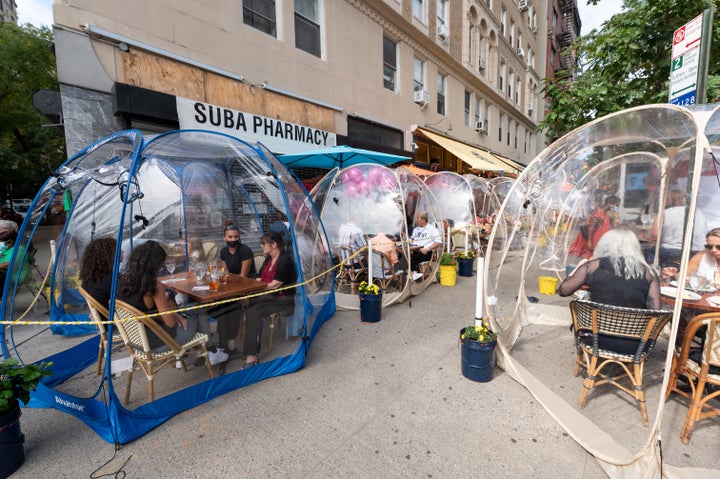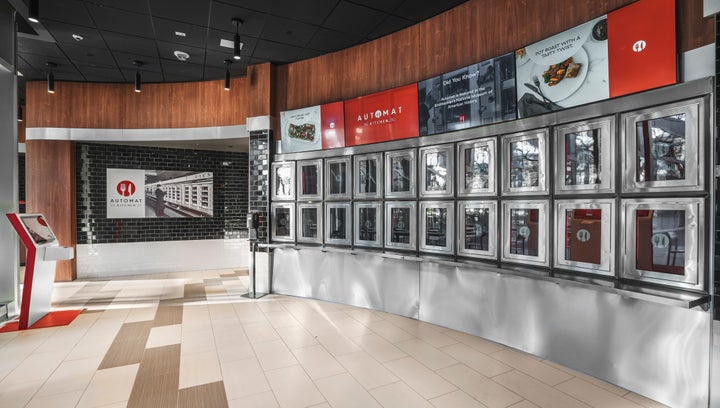It’s been a year since the coronavirus pandemic upended the U.S. restaurant industry, necessitating innovations in takeout, carry-out cocktails, expanding outdoor dining and contactless technology. Trends that weren’t supposed to take hold for years have occurred at an accelerated rate.
“Looking at 2020, obviously it was the worst year in history for the United States restaurant industry,” said Hudson Riehle, senior vice president of the research and knowledge group for the National Restaurant Association. “In all the industries in America, the restaurant industry was the most impacted in terms of employment and sales decline.”
Riehle said 2020 ended with an estimated $240 billion less sales than 2019 — a 19.2% decrease — and that 2 million restaurant workers remain out of work, even though the country is staring to reopen.
HuffPost spoke with industry experts on what restaurants will look like after the pandemic. One thing everyone agreed upon: Recovery will take time.
“It’s going to be very hard to have a thriving independent restaurant business when you’re basically trying to climb out of debt,” said Edward Lee, chef, restaurateur and co-founder of the philanthropic The Lee Initiative. “I think it’s going to be very challenging and no one ultimately knows what’s going to happen. Will restaurants have the money to support the small, independent farms? Will small, independent restaurants be able to do all the cool things they used to do before, with the decorations and the meaningful menus? All that stuff costs money.”
“The restaurant crisis is still going to be with us for a while,” Lee added, noting that it’s currently challenging for restaurant owners to get money from both banks and private investors.
Riehle said business should pick up as the vaccine rollout continues and it gets warmer around the country.
“But it’s still a huge abyss to overcome,” he said.

Sluggish Indoor Dining
With vaccines in high gear — including inoculations of restaurant workers — and dining rooms reopening across the country, it should be safe to eat indoors again if you’ve been fully vaccinated. However, Lee said consumers are reluctant to do so.
“There’s been a lot of damage done to restaurants. Not just financially, but also from a public standpoint,” he said. “There was a lot of restaurant-bashing that was being done during the pandemic, and a lot of people created this unfair narrative where restaurants were reopening simply out of profit, and that just wasn’t the case.”
Lee kept most of his restaurants operating — and even opened the brand-new Cincinnati restaurant Khora in October — so his employees could keep their health insurance during the pandemic.
“There’s a romance to restaurants, and I am fighting so hard not to lose that.”
- Edward Lee, chef
It may take some time, but industry experts say people will probably become increasingly comfortable returning to pre-pandemic dining situations.
“There’s a romance to restaurants, and I am fighting so hard not to lose that,” Lee said.
Caroline Styne, a co-owner of the Los Angeles-based Lucques Group who managed to keep A.O.C Wine Bar open with partner Suzanne Goin, agreed.
“As people get vaccinated, they’re feeling more and more comfortable about being out,” said Styne, who is also on the advisory board of the Independent Restaurant Coalition, which worked with Congress to pass the Restaurant Revitalization Fund. “I know I am. Actually, I ate indoors at a restaurant last night, a very small restaurant. My family and I all looked at each other going, ‘We’re all vaccinated, so I guess it’s OK.’”
Styne is a fan of communal tables and hopes the seating option, along with general conviviality, returns to restaurants.
“I think people will be inching closer and closer together,” she said. “People want to sit at a bar and have a drink. I think that in general, human beings want to be near other human beings, really closely. I think the year is going to see a very slow moment of tables getting closer and closer. But I’m not sure if by the end of the year that we will be back to our original seating arrangements.”

Justin Hill, principal at Seattle-based architecture firm MG2, said his organization’s research showed that 75% of people plan to continue using curbside pickup after the pandemic and that 31% were less willing to use communal seating.
Off-Premises Options Are Here To Stay
Riehle said off-premises sales — meaning takeout, curbside pickup and delivery — accounted for 60% of all restaurant traffic before the pandemic, but increased to 90% during the second quarter of last year. And he doesn’t see takeout sales returning to pre-pandemic levels.
For Elaine Townsend, co-owner of the newly opened Cincinnati-based Asian-inspired pastry and ramen shop Mochiko, said she lucked out and found a brick-and-mortar with a takeout window.
“It was a very big selling point for us when we chose this spot,” she said. “With how unpredictable things have been during the pandemic, the ability to provide both quick service and dine-in service, when it became an option again, was something we knew we needed to have.”
“Human beings want to be near other human beings, really closely. I think the year is going to see a very slow moment of tables getting closer and closer.”
- Caroline Styne, co-owner of the Los Angeles-based Lucques Group
Another sector that has seen pandemic-era ubiquity is ghost kitchens, or delivery-only kitchens — which Riehle called “a long-term trend and not a fad,” even though less than 5% of operators have added delivery from a virtual or ghost kitchen since the beginning of the pandemic
Townsend explained the appeal of ghost kitchens: “It allows a chef or owner of a small business to be able to sell their food without the same costs involved in a full restaurant like designing and building out a space, as well as hiring a large front-of-house staff.”
The Return Of Automats
Automats, which allow people to put a coin into a vending machine and purchased a pre-packaged meal, arrived in the U.S. in 1902. They practically went extinct 30 years ago, then experienced a brief revival in the aughts.
“Automats originally disappeared because of shifts in culture and eating habits that [automats] didn’t adapt to,” said Joe Scutellaro, the principal owner of Automat Kitchen in Jersey City. “People were moving away from cities to suburbs. Fast food chains were popping up on every corner, and taste preferences were changing quickly. People were looking for healthier, fresh options.”
But between his establishment, New York’s Brooklyn Dumpling Shop and Portland’s Pix Pâtisserie, the pandemic-ready option is back.
They work a little differently now, though. At Automat Kitchen, for example, customers can order global-inspired food online (it’s all made fresh) and pick it up from a food locker inside the restaurant. Customers unlock the locker with their phone and only touch the food bag. (The restaurant also has indoor and outdoor dining options.)

Will automats replace human employees? Probably not.
“The future of food service and technology needs to be human-centric and focused on customer benefits,” Scutellaro said. “It all falls apart without the passion, perspective and empathy that technology just can’t deliver. And it also means that the digital, mobile and physical footprint of restaurants will need to become more blended and customized too.”
Smaller Staffs
Styne said restaurant staffs will probably shrink, especially initially.
“We’ve all gotten by with less,” she said. “Everyone has had to dig in and change the way they work and maybe change the way they operate to accommodate lower staffing levels, and I’m sure some people will keep it that way. It’s a shame because you don’t want the jobs to be lost.”
She mentioned some people have also been reluctant to return to work out of fear, which affects staffing.
“I think people have been stuck at home for a year and haven’t been out and haven’t changed their habits and are afraid,” she said. “It’s just going to take time for people to get used to the idea that, ‘Oh, I can be around people again. That’s right. I’m not going to die the minute I walk out the front door.’”
A Focus On Fixing Inequalities
“Although I’m tired of the phrase ‘the new normal,’ it is an accurate description of our next future-state,” Hill said. “We can’t unlearn or erase the emotional memory of what we’ve all just experienced.”
“What the pandemic did was give everyone time to reflect. I do hope that the other side of this is a restaurant industry that’s kinder, more activist, more worker-friendly, more sympathetic, and more about truly a community.”
- Lee
Both Lee and Styne would like to use the lessons of past year to correct the wrongs of the industry.
“My fear is that humans have very short memories,” Styne said, noting that the past year has made people pay attention to important issues such as Black Lives Matter, anti-Asian violence, mistreatment of women and other forms of inequality.
“If we can keep shining a light on these things that have come out in the pandemic, then that would be a godsend, because we need to be a more tolerant, understanding and a tighter community than we are,” she said.
“What the pandemic did was give everyone time to reflect,” Lee said. “You don’t fix the system overnight. It’s not going to happen with a snap of a finger. I do hope that the other side of this is a restaurant industry that’s kinder, more activist, more worker-friendly, more sympathetic, and more about truly a community. At the end of the day, it’s made up of good people. We hear change. We want change. We see it. It’s just how to get to that finish line. It’s going to be challenging, but the restaurant industry is always met with challenges. We’ll meet this one, too.”
